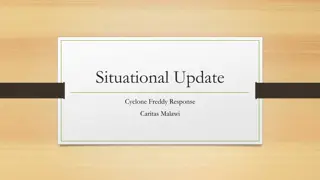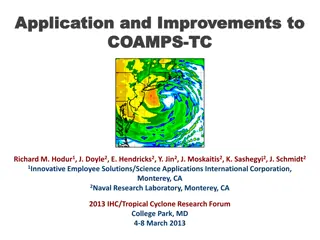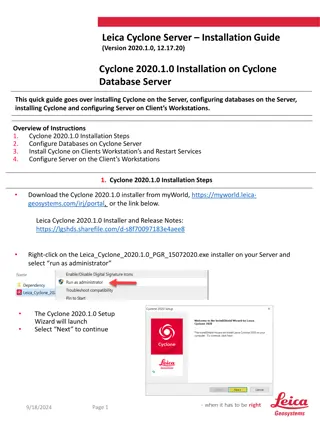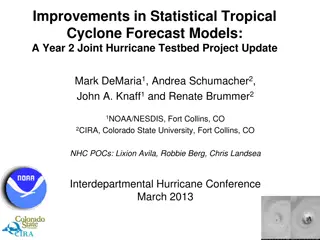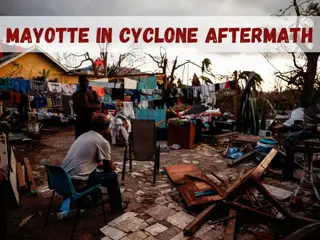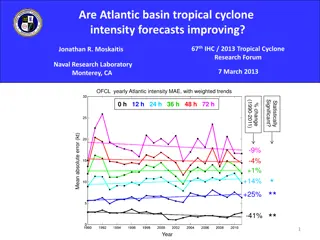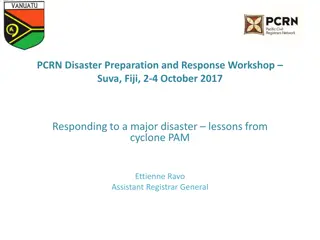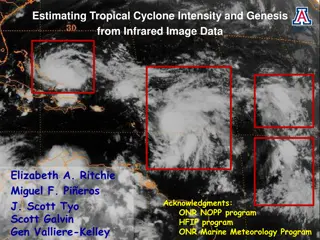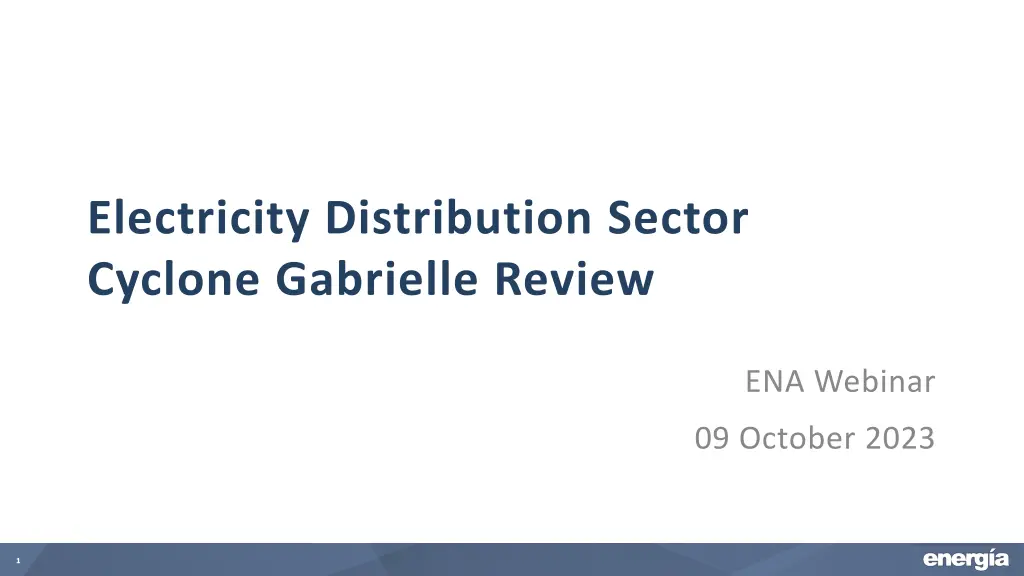
Review of Electricity Distribution Sector Impact During Cyclone Gabrielle
Discover the impact of Cyclone Gabrielle on the electricity distribution sector, including customer disruptions and network damages. Learn about the lessons learned and ways to enhance sector resilience discussed in the ENA webinar on October 9, 2023.
Download Presentation

Please find below an Image/Link to download the presentation.
The content on the website is provided AS IS for your information and personal use only. It may not be sold, licensed, or shared on other websites without obtaining consent from the author. If you encounter any issues during the download, it is possible that the publisher has removed the file from their server.
You are allowed to download the files provided on this website for personal or commercial use, subject to the condition that they are used lawfully. All files are the property of their respective owners.
The content on the website is provided AS IS for your information and personal use only. It may not be sold, licensed, or shared on other websites without obtaining consent from the author.
E N D
Presentation Transcript
Electricity Distribution Sector Cyclone Gabrielle Review ENA Webinar 09 October 2023 1
Agenda In this presentation, we cover three broad themes: What was the impact on customers and networks? What went well? What did we learn, and how could the sector's resilience be improved? 2
Impact (1/3) At its peak, 240,000 customers lost supply (11% of NZ) Cyclone Gabrielle, Customers-Off Curve, Outage Cause 250 Asset Damage from Out-of-Zone Trees Asset Damage from Adverse Weather (Wind and Flooding) In relation to the distribution sector Out-of-zone trees falling on lines (which are trees outside of EDBs areas of control) interrupted 67,000 customers. This was the largest single cause of outage Storms conditions above design limits interrupted a further 63,000 customers Flooding was also a material factor, impacting over 62,000 customers Asset Damage from Other Vegetation (Largely transmission related) 200 Customers without supply (000) Other Causes Out of zone trees were the largest cause of outages 150 100 50 0 10 Feb 11 Feb 12 Feb 13 Feb 14 Feb 15 Feb 16 Feb 17 Feb 18 Feb 19 Feb Date 20 Feb 21 Feb 22 Feb 23 Feb 24 Feb 25 Feb 26 Feb 27 Feb 28 Feb 3
Impact (2/3) Cyclone Gabrielle, Customers-Off Curve, by Cause Contributing factors The duration of cyclonic conditions delay restoration, and the first two days were mainly make-safe and network switching There were over 2,200 outages, many with significant damage. This created a very high demand for control room resources, field resources, and materials that would have impacted restoration time The outage duration was the longest for customers in Hawkes Bay and the Far North 120% Customers Off, All EDBs, Adverse Weather Customers Off, All EDBs, Out-of-zone tree Customers without supply (% of maximum) Customers Off, All EDBs, Flooding Customers Off, All EDBs, Slip 100% Percentage of Customers Off (End-of-day) 80% Tree damage occured early due to the strong winds The flood damage required substantial work to restore the bulk of customers 60% 40% The wind damage was wide- spread at a large number of site, which took the longest to repair 20% 0% 10/02/23 11/02/23 12/02/23 13/02/23 14/02/23 15/02/23 16/02/23 17/02/23 18/02/23 19/02/23 Date 20/02/23 21/02/23 22/02/23 23/02/23 24/02/23 25/02/23 26/02/23 27/02/23 28/02/23 4
Impact (3/3) Subtransmission and critical feeders performed well Showed the benefit of prior investment in network hardening and security Subtransmission fault rate was less than half of distribution (1.8 vs. 4.0 outages per 100km) Subtransmission and critical feeders were also restored quicker (i.e. they were given a higher priority and there more alternatives available) Cyclone Gabrielle, Customers-Off Curve, Network Level 250 Distribution Feeders Transmission Subtransmission and Zone Substations Customers without supply (000) 200 Critical Distribution Feeders 150 100 The substransmission, zone substations and critical feeders performed well, reflecting the inherent security for these parts of the network 50 0 10/02/23 11/02/23 12/02/23 13/02/23 14/02/23 15/02/23 16/02/23 17/02/23 18/02/23 19/02/23 Date 20/02/23 21/02/23 22/02/23 23/02/23 24/02/23 25/02/23 26/02/23 27/02/23 28/02/23 5
What went well Core network security, preparedness, and industry support kept outages to a minimum and assisted in restoring supply What went well Core network security Networks have inherent redundancy in critical areas (i.e. subtransmission and feeders supplying important customers) and those areas stood-up well during the event, accounting for only 4% of outages this shows the benefit of prior investment in network hardening Preparedness EDBs have robust emergency management plans and management structures. These are well tested and are continuously being improved through experience. Response actions were initiated in advance, albeit that the full scale of the event was not clear. Pan-industry support Restoring supply into the Hawkes Bay and Tair whiti took innovation and coordination by Transpower, Unison, Genesis and Firstlight minimising the outage time Mutual aid When the scale of the event became clear, resources were shared across the industry to affected areas improving restoration time Customer communication Despite some external telecommunication challenges, customers were kept informed using a mix of media. We received good feedback 6
Key conclusions Reduce the height and shorten the length of the customers off curve! Cyclone Gabrielle, Summary of Improvements 250 Reduction in Asset Hazards Reduction in Out-of-Zone Trees Improvement in Resourcing and Access 200 Customers without supply (000) 1 Reduce the number of customers lost: Reducing risk (minimising vulnerably of the subtransmission, zone substations and core feeders) Reduce exposure to out-of-zone trees 1 Reducing network risk and exposure to out-of-zone trees reduces the number of customers lost 150 2 100 Continuous improvement in resources and access reduces the length of the tail. Community hubs as the fall-back 3 Reduce the restoration time Continuous improvement in resourcing sharing and access contingency 50 2 0 10 Feb 11 Feb 12 Feb 13 Feb 14 Feb 15 Feb 16 Feb 17 Feb 18 Feb 19 Feb Date 20 Feb 21 Feb 22 Feb 23 Feb 24 Feb 25 Feb 26 Feb 27 Feb 28 Feb Strengthen the fall-back 3
Learningsrisk reduction (1/2) Risk reduction was generally good, but needs to evolve further The identification of hazards and assets vulnerable to them is generally robust for typical hazards but work is at an earlier stage in relation to flooding, geotechnical hazards, and assessing how hazards may alter with climate change Current designs performed well. EDBs apply post-disaster standards to zone substation and control room design (with minor expectations for less critical assets) The standards in relation to flooding (for post-disaster operations) do not appear to be as clearly defined as those applying to structural performance 8
Learningsrisk reduction (2/2) Risk reduction Pre-2000 overhead lines were designed to a lower standard The windspeeds experienced in some locations during Cyclone Gabrielle were highly likely to have been above the design limits for pre-2000 lines Current rules constrain the ability of EDBs to manage trees that present a fall-risk to lines 9
Learningscauses The inability to reduce some risks and not fully recognising others drove the scale of the outage Out-of-zone trees were the largest cause of outages and could not be mitigated prior due to the narrow focus of the current tree regs The flooding damage in Hawkes Bay was significant, and that vulnerability (overtopping flood banks) was not well understood nor mitigated prior. It was also a complex restoration that took time to complete The significant number of outages (that was difficult to anticipate and plan for with foresight) caused resource constraints impacting restoration time mutual aid was provided but took time to arrive Access restrictions, to the extent they occurred, were not anticipated 10
Learningsresources Resource escalation helps, but has its limits Field resource escalation has its limit. In this case due to the number of companies impacted (restricting availability), roading damage (restricting access), and logistics and management limitations within affected businesses Control room resource constraints were experienced in the areas where damage was greatest, but due to commonality in some control systems, resources could be transferred from SI companies to NI companies. This provide some relief, but didn t fully resolve constraints Controllers resource escalation also has its limit, due to the size of the resource pool and limited buddy-support in the host company 11
Learningsinterdependencies Interdependencies caused delays The failure of the roading network was material on the East Coast, Hawkes Bay and rural areas around Auckland. Roading damage, and lack of visibility of the roading damage, impacted planning and delayed restoration efforts The communications failure (due to back-haul fibre damage) on the East Coast was material and prevented customers from reporting faults. This, combined with the access issues and delays in aerial surveys, impacted restoration Failure of public telecommunications due to short cell-tower battery backup impacted field and network communications and delayed restoration efforts
Actions to drive improvements Drivers of improvements (more details in the report) Specific asset upgrades, incremental improvement (as assets are renewed), and alternative arrangement (e.g. micro-grids) will reduce risks regulatory support for resilience investments (balanced against affordability) and RMA changes to reduce the consenting hurdle for route diversity is needed Greater rights to incentivise landowners and enable EDBs to manage trees Revision to tree regs to better control over lines corridor to improve resilience There are hard to access areas where restoration may be delayed community hubs will enhance support Continuous improvement in resourcing, access, coordination, and communication will improve outcomes for customers



